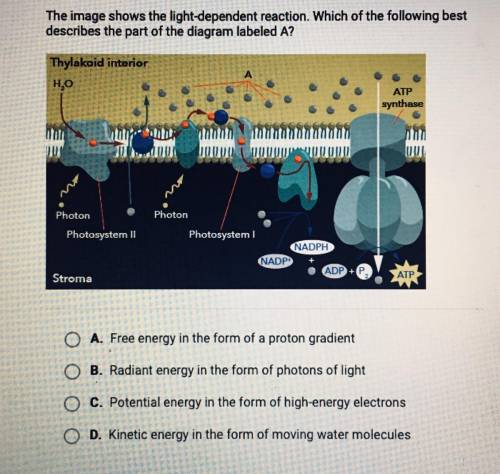
Biology, 21.06.2020 08:57 angeladominguezgarci
A. Free energy in the form of a proton gradient
B. Radiant energy in the form of photons of light
C. Potential energy in the form of high-energy electrons
D. Kinetic energy in the form of moving water molecules


Answers: 1


Other questions on the subject: Biology

Biology, 22.06.2019 03:30, Damagingawsomeness2
For this question look at the hydropic diagram water that is heated by the sun evaporates. select the number that represents it.
Answers: 1

Biology, 22.06.2019 05:30, awesome266
This map shows how climate change might affect precipitation patterns in the great plains of the united states by the end of this century. brown shoes a decrease in percipitation, and blue shows an increase. the maps differ based on the predictive levels of green house emissions. the maps shows that northern area should get a. more pracipations regardless of emmissions b. less pracipation, regardless of emmissions levels c. more precipitation, but only when emission levels. southern areas show a. more pracipations regardless of emmissions b. less pracipation, regardless of emmissions levels c. more precipitation, but only when emission levels. to use these maps to prepare for natural disasters in the great plains, scientist need to ask? a. how many tons of emissions were used at the basis of the map. b. which types of fossil fuels are used in the great plains c. if you think the above is wrong it's probly c the question is cut off
Answers: 1

Biology, 22.06.2019 07:00, victorialeverp714lg
According the inverse square law, doubling the distance from the source of the sound, a speaker, for example, will drop the sound 6 db each time. if you were standing in the back of an auditorium, 32 feet away from a speaker not using any amplification, would you be able to hear a speaker clearly? why or why not?
Answers: 2

Biology, 22.06.2019 09:10, dmarte11092001
Explain the cellular functions that occur when antibiotics attack a bacteria cell. a. antibiotics target the cell wall, cell membrane, and the processes of protein and nucleic acids production in bacteria to rupture the cell. b. antibiotics create dormant resistant endospores to preserve the genetic material and rupture the cell. c. antibiotics target the cell wall and form a bridge-like connection to form conjugation. d. antibiotics use binary fission to grow twice its size, replications its dna, and split into two cells.
Answers: 2
You know the right answer?
A. Free energy in the form of a proton gradient
B. Radiant energy in the form of photons of light
Questions in other subjects:

Mathematics, 23.09.2019 21:30


Mathematics, 23.09.2019 21:30

History, 23.09.2019 21:30

History, 23.09.2019 21:30


Mathematics, 23.09.2019 21:30

Mathematics, 23.09.2019 21:30

History, 23.09.2019 21:30

Computers and Technology, 23.09.2019 21:30



